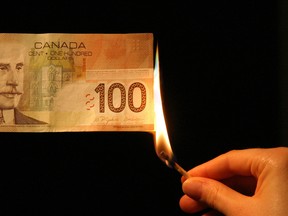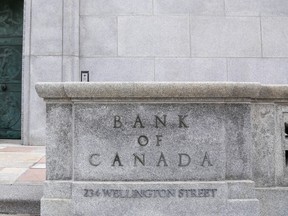Inverted yield curve is flagging high recession risk while stock market rally never had the necessary underlying fundamentals
Article content
No matter how you slice and dice it, one thing is clear: the reflexive stock market rally that began last October (and ended this past August) never had much in the way of fundamental underpinnings. Momentum, yes. Technical picture, yes. Sentiment and emotion, yes. Fundamentals and valuations, sorry, no. And this is why we never bit despite all the external pressure to do so. Everyone loves a bullish narrative.
Advertisement 2
Article content
Meanwhile, the Conference Board’s leading economic index has fallen for 17 consecutive months as economic uncertainty continues to grow, and the ISM manufacturing purchasing managers’ index (PMI) has been in contraction (sub-50 print) mode for 10 straight months and has been in decay since March 2021. Delinquency rates on credit card loans have soared to 11-year highs, and to the early 2020 peak for auto and related credit. Germany is on the precipice of a recession, Japan is seeing contracting domestic demand and China is in the throes of a debt-default and asset-deflation cycle — cyclical negatives bumping against a secular slowdown.
Article content
And we have a United States Federal Reserve with a complacent view on the U.S. economic outlook and an obsession with its inflation target of two per cent, which has sent the Treasury curve to the highest level since just before the onset of the late-2007 Great Recession.
Meanwhile, the average of nominal gross domestic product and gross domestic income growth in the U.S. has been wound down to just around 4.5 per cent from 10.1 per cent a year ago — this is characterized as “solid” by the central bank. The historical norm is much closer to seven per cent at an annual rate. At around 4.5 per cent presently, the trend is back to where it was in the first quarter of 2021 when the S&P 500 was 3,900 and the 10-year T-note was 1.3 per cent.
Article content
Advertisement 3
Article content
This is nearly identical to the average nominal economic growth we had on our hands in late 1990, when the U.S. economy was knee-deep in recession (one that forced the Fed to eventually cut the funds rate by nearly 700 basis points); the first quarter of 2001, when that recession was just beginning; the summer of 2007, just six months ahead of another recession the Fed and the consensus failed to see coming; and in mid-2010, when then Fed chair Ben Bernanke prematurely declared there to be “economic green shoots” sprouting up (never mind we entered the weakest post-recession recovery ever recorded).
Anyone who puts credence on what the Fed, an institution that moved from “transitory” to “higher for longer” in a span of less than two years, has to say should be reminded that when the central bank develops labels such as these, it typically is a time to place bets the other way.
The S&P 500 is still up just over 11 per cent year to date with year-over-year earnings on track to decline 1.3 per cent this quarter, which implies the rise in the S&P 500 is wholly a result of an increase in price-to-earnings (PE) multiples. But these high P/E multiples look unsustainable in the face of a higher-for-longer Fed and a ridiculous 100-basis-point equity risk premium. You are paying to take on risk in the stock market as an asset class instead of being paid to take on the risk at these relative valuation levels.
Advertisement 4
Article content
Real rates, at more than two per cent, alongside contracting monetary and credit aggregates, represent a severe tightening in financial conditions, accentuated by the run-up in the U.S. dollar. The end of all the pandemic stimulus, which fattened household pocketbooks, is going to loom large heading into the fourth quarter just as the effects of the Fed’s policy tightening are felt. And it’s not just rates, but the quantitative-tightening process promises to weigh on asset prices (just as quantitative easing bloated asset valuations in the past), and this is going to catch a whole lot of macro bulls by surprise. This is the same group, as an aside, that also extrapolated the 2000 soft landing into 2002 and the 2007 soft landing into 2008.
While there is still some leftover “industrial policy” stimulus from the prior rounds of fiscal largess, this type of government intervention influences the economy with a long gestation period and will not have much of a bearing on the contours of the business cycle.
The question is what happened to all those calls this past spring and summer about the onset of a whole new bull market? That was always a case of missing the forest for the trees, and ignoring the weak market breadth, even during the rally phase.
Advertisement 5
Article content
Now, the weak breadth is even more notable, but even when the market was sharply rising earlier this year, the fact that the banks, small caps and equal-weighted S&P 500 were lagging so far behind made it very difficult to believe this rally had legs. And as powerful as it was, and we saw similar reflex rallies in 2002 and 2008, without the traditional early stage leaders blazing the trail, all bets were off on the veracity of this upward move. We said it then and we say it now.
Related Stories
-

Rosenberg: We’re calling bull on the ‘new bull market’
-

Why now’s the time for investors to buy Canada
-

More evidence Bank of Canada should stop hiking
As for the economy, not only is the much-maligned inverted yield curve flagging elevated recession risk, understanding that the lags are always long and variable, but we have also endured a 24-month span where the S&P 500 cap-weighted index is completely flat … and back to 1970, this too has foreshadowed all recessions with 100 per cent precision, with an average lead-time of six months. The problem is that valuations still do not reflect this heightened risk.
David Rosenberg is founder of independent research firm Rosenberg Research & Associates Inc. To receive more of David Rosenberg’s insights and analysis, you can sign up for a complimentary, one-month trial on the Rosenberg Research website.
Article content
David Rosenberg: Investors and economists are playing with fire
2023-09-27 15:04:42





Comments
Postmedia is committed to maintaining a lively but civil forum for discussion and encourage all readers to share their views on our articles. Comments may take up to an hour for moderation before appearing on the site. We ask you to keep your comments relevant and respectful. We have enabled email notifications—you will now receive an email if you receive a reply to your comment, there is an update to a comment thread you follow or if a user you follow comments. Visit our Community Guidelines for more information and details on how to adjust your email settings.